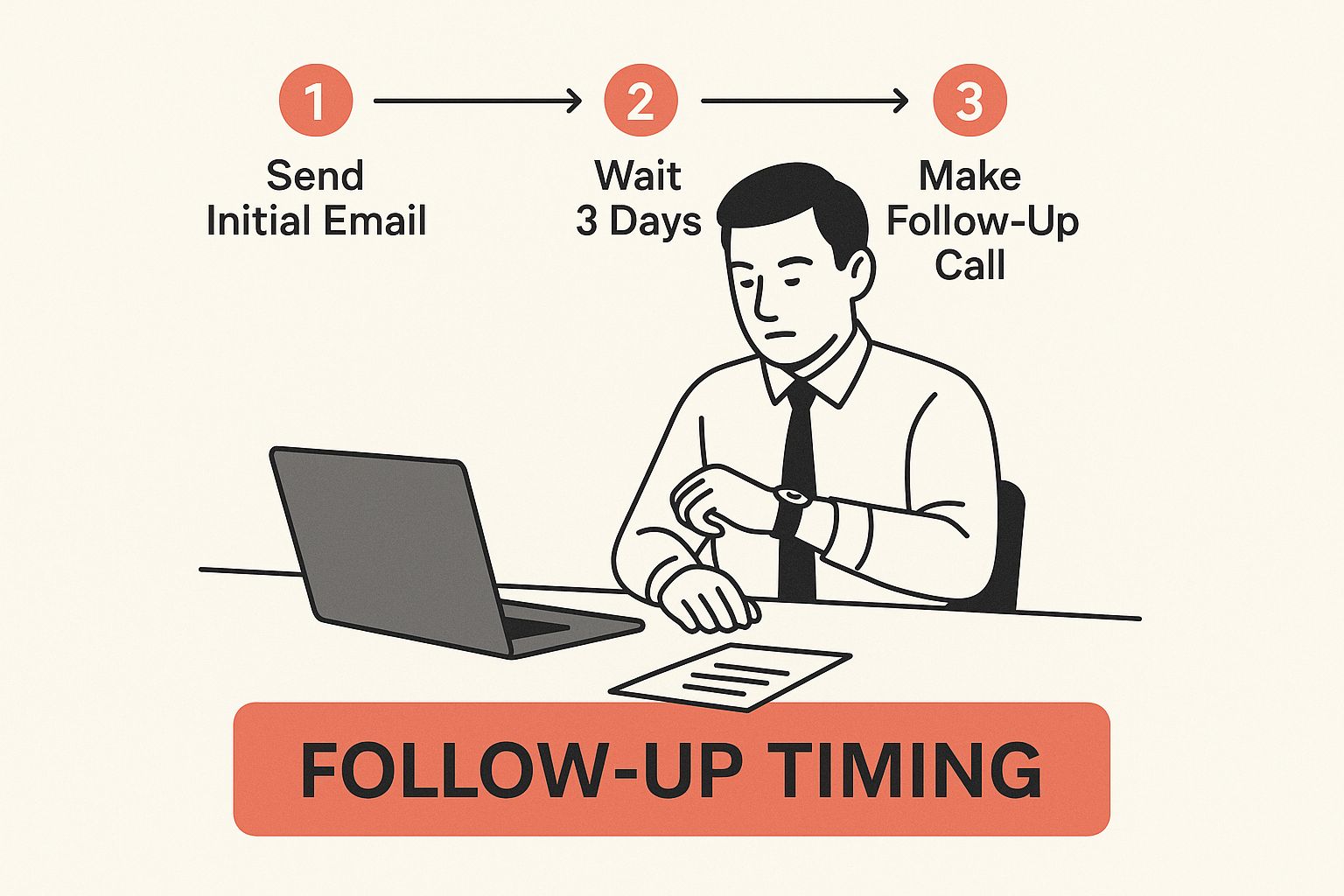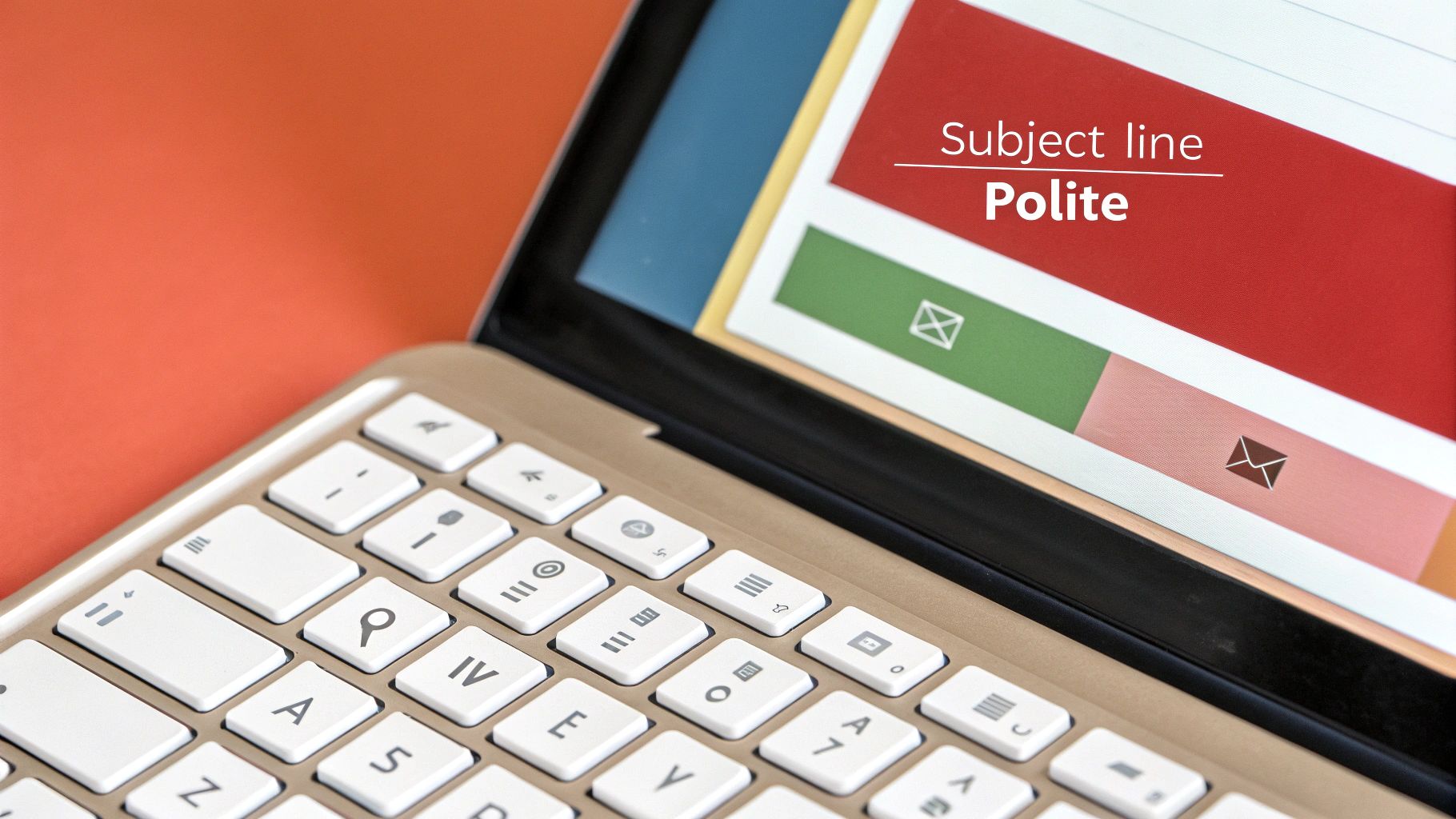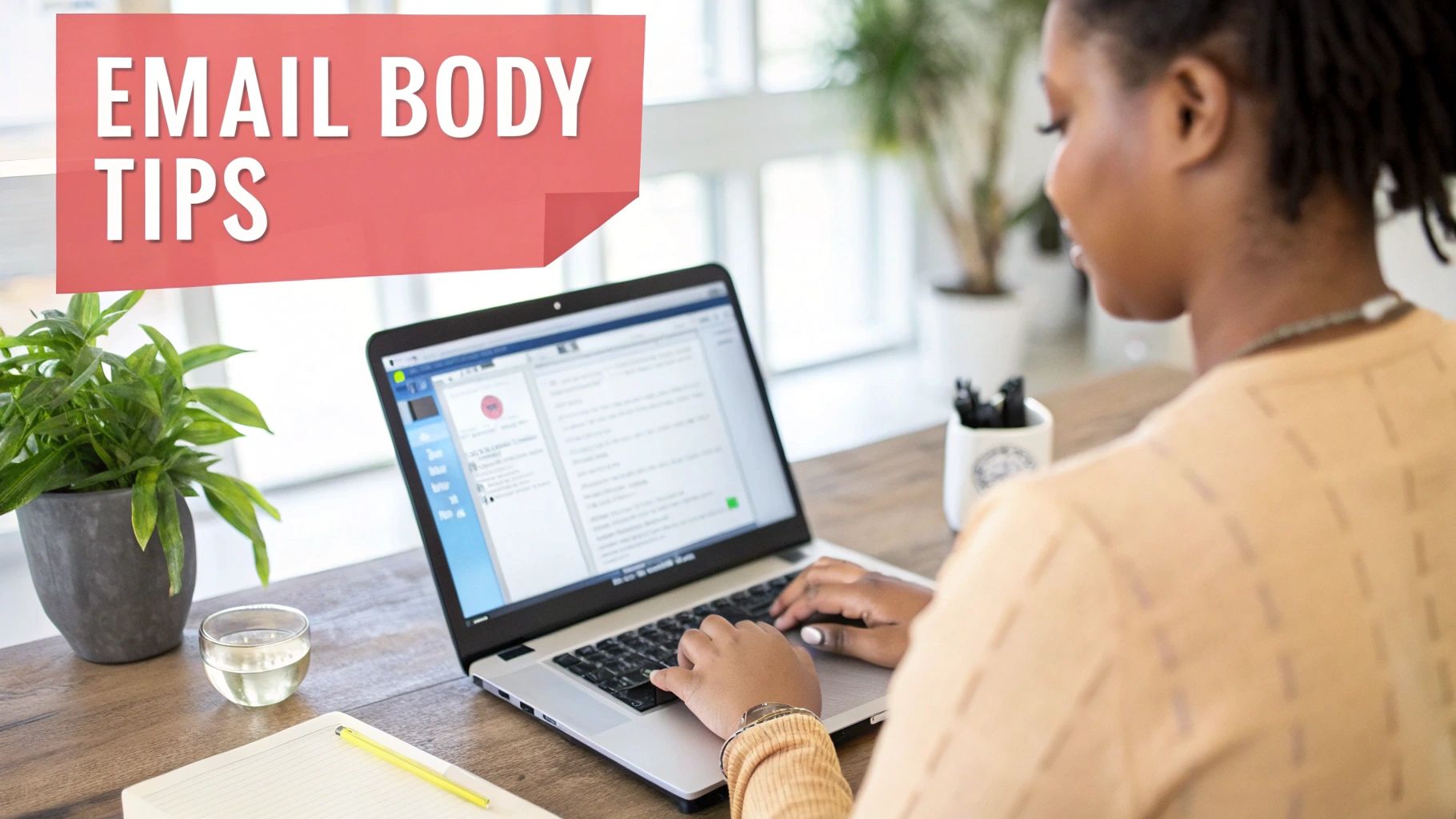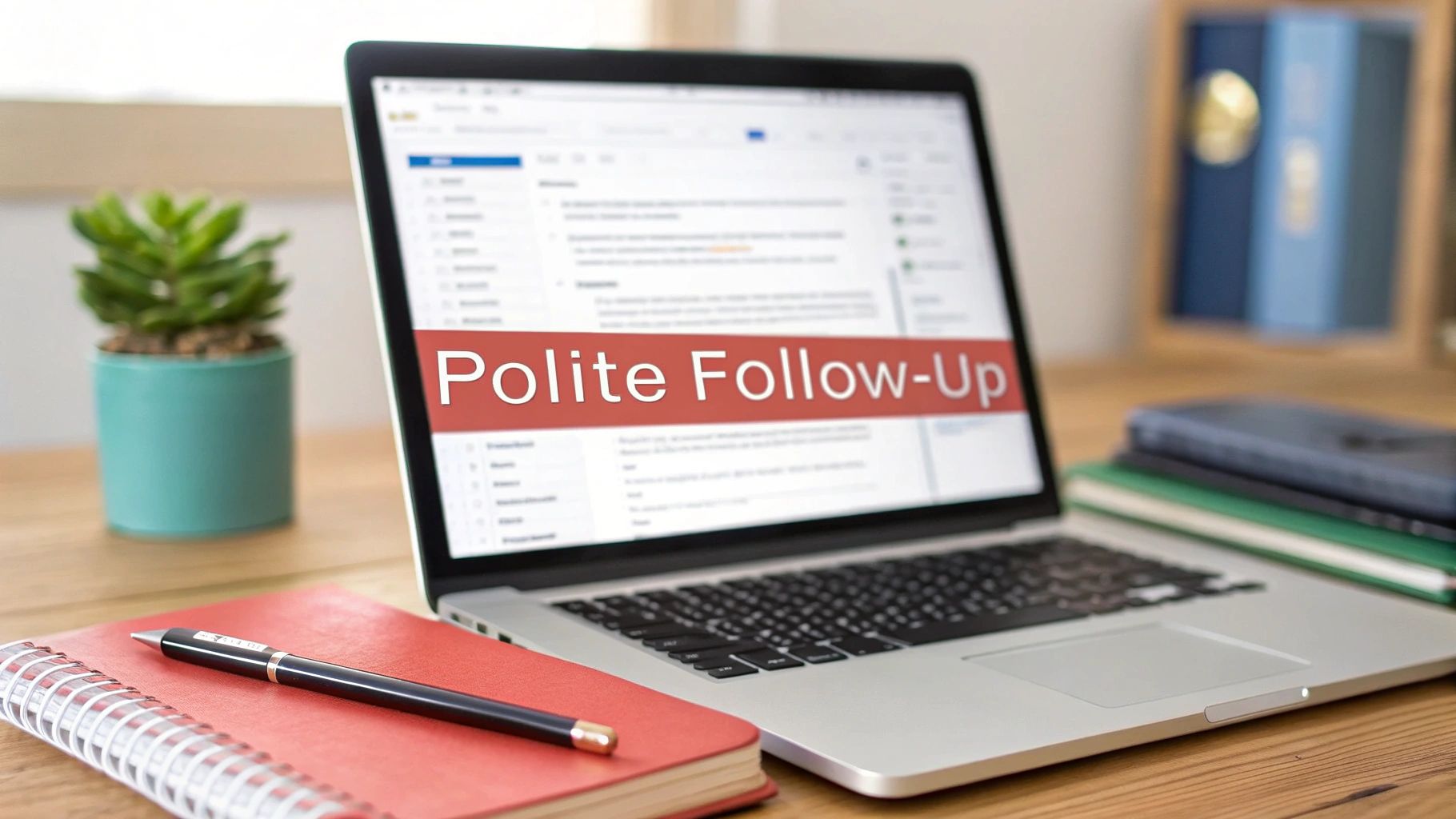Knowing how to politely follow up on an email is a real art for any agency. It’s all about finding that perfect balance—providing context, adding a little extra value, and using perfect timing to create a gentle nudge, not an annoying poke.
The goal is to be persistent without being a pest. When you get it right, you reinforce your agency's professionalism and keep the conversation moving forward. Honestly, this skill is one of the most underrated ways to turn radio silence into a successful client engagement.
Why Polite Follow-Ups Are a Critical Agency Skill
Let’s be real—the silence after you send a crucial email to a client or prospect can be deafening. For agencies, mastering the polite follow-up isn't just good manners; it's a core business function that has a direct line to your bottom line and reputation.
It's what separates a proposal that gets signed from one that gets buried in a crowded inbox.
Every unanswered email is a potential missed opportunity for your agency. It could be a new deal hanging in the balance, crucial feedback on a campaign, or even just a past-due invoice. But the objective isn't just to get any reply. A strategic follow-up shows your agency is professional, organized, and genuinely invested in your client's success. This kind of thoughtful communication builds and nurtures relationships, projecting unwavering competence even when things go quiet.
The Proven Power of Persistent Follow-Ups for Agencies
The data absolutely backs this up. Follow-up emails can dramatically boost response rates. Some studies show they can nearly double your chances of getting a reply. In fact, a well-executed follow-up sequence often achieves an 85% higher reply rate than just sending a single email and hoping for the best. If you want to dig into the numbers, you can see the full study on follow-up effectiveness.
A polite follow-up demonstrates persistence and professionalism, showing a client you value their business enough to not let the conversation fall through the cracks. It protects your agency's reputation by preventing communication breakdowns.
For a broader look at crafting effective emails, it’s worth diving into these comprehensive email marketing best practices. At the end of the day, these small interactions are central to how an agency operates, making solid communication a must-have skill. Improving your team's approach is one of the most important client communication best practices you can adopt.
The Art of Timing Your Agency's Follow-Up Email
In agency life, timing is everything. Seriously. Follow up too quickly, and you come off as pushy. Wait too long, and you risk getting lost in the shuffle, your message completely forgotten.
Getting the timing right isn't just about being polite—it's a strategic move. It shows you respect your contact's time while keeping your project right where it needs to be: on their radar. Think of it as the fine line between a welcome nudge and becoming an inbox pest.
This infographic lays out the ideal timing for your follow-ups in a clear, visual way.

As you can see, the flow highlights just how important strategic gaps are for keeping the momentum going without overwhelming the person on the other end.
Optimal Timing for Common Agency Scenarios
Different situations call for different clocks. A hot lead who just wrapped up a fantastic discovery call needs a much quicker response than a cold prospect you're trying to warm up over a few weeks.
For example, after you've sent over a detailed proposal, giving a client 3-5 business days to look it over is pretty standard. It gives them enough breathing room to actually read it and chat with their team. On the flip side, a quick check-in just 24-48 hours after a great discovery call helps capitalize on all that initial excitement.
It's also crucial to understand the psychology behind the silence. No response doesn't automatically mean "no." More often than not, it means your contact is swamped, waiting for approval from their boss, or just dealing with a dozen other priorities. A well-timed, polite nudge respects all of that.
When you know how to follow up on an email politely, you reframe the entire interaction. Instead of asking, "Why haven't you replied?", you're gently asking, "Is there anything I can do to help move this forward?"
This isn't just theory—it actually works. The data backs it up, showing that sending at least three follow-up emails can boost response rates by about 28%. And if you use a well-planned schedule with strategic intervals, you could see a 40% higher response rate compared to just winging it. You can dig into more cold email statistics on saleshandy.com.
To make this super practical for your day-to-day agency work, I've put together a little cheat sheet.
Your Agency's Follow-Up Timing Cheat Sheet
Here’s a quick-glance table to help you nail the timing for some of the most common scenarios your agency will run into.
Use this as a starting point and tweak it based on your relationship with the client and the specific context of your conversation. A little bit of planning goes a long way.
How to Write a Follow-Up Email That Gets Opened and Read
Knowing when to follow up is half the battle. The other half? Knowing what to say. For your agency, crafting a polite follow-up email that gets a reply requires a delicate balance between persistence and genuine value.
It all starts with the subject line. Let's be honest, we all ignore emails with generic subject lines like "Following up." Your goal is to write something that instantly jogs their memory.

Craft a Memorable Subject Line to Stand Out
You want to make it as easy as possible for them to recognize your email in a crowded inbox. The best way to do that is to connect it back to your last conversation.
Here’s how to transform a bland subject line into something specific and helpful:
Instead of: "Following up"
Try: "Quick question on the [Project Name] proposal"
Instead of: "Checking in"
Try: "Next steps after our call about [Service]"
These small tweaks immediately provide context, signaling that your email is relevant and not just another generic nudge. It shows you respect their time and will seriously boost your open rates.
The Anatomy of an Effective Agency Follow-Up Email
Once they’ve opened it, the email body needs to be concise, polite, and have a clear purpose. A great follow-up has four key ingredients that work together to prompt a response without feeling pushy.
First, a gentle reminder. Briefly and lightly remind them of your last interaction or the original email's purpose. It's best to assume they’ve just been busy.
Second, a genuine value-add. This is your secret weapon. Instead of just asking for an update, provide something useful. This could be a relevant case study, an article that speaks to one of their pain points, or a helpful resource you came across.
Third, a clear, low-pressure CTA. Make it incredibly easy for them to reply. Ask a simple, direct question or suggest a next step that doesn’t require a huge commitment.
And finally, strategic personalization. A single cold email almost never works; the data shows about 95% fail to get a response. But campaigns that use advanced personalization can see reply rates as high as 18%, yet very few agencies take the time to personalize every message.
Proven Phrases for Agency Follow-Ups:
- "Just wanted to gently follow up on the proposal I sent last Tuesday..."
- "Circling back on our conversation about [Project]—I came across this article on [Topic] and thought you might find it interesting..."
- "Is this still a priority for you, or should I check back in a few weeks?"
For agencies building out a larger outreach plan, these nuances are a core part of most effective email marketing strategies. Ultimately, the perfect follow-up continues the conversation by being helpful, not demanding. If you want more tips on this, feel free to https://scribbl.co/post/requesting-a-meeting-email.
Field-Tested Follow-Up Email Templates for Your Agency
Knowing how to politely follow up is so much easier when you have a solid framework to start from. Instead of staring at a blank screen, your team can grab one of these field-tested templates designed for the exact situations your agency runs into every day.
Think of these less as copy-paste scripts and more as nuanced starting points. They give you the structure you need while leaving room to inject your own personality, keeping things professional but still human.

Template 1: For a Gentle Nudge on an Overdue Invoice
Chasing down payments is always a bit awkward, but it's a non-negotiable part of running an agency. The trick is to stay polite and professional, giving the client the benefit of the doubt that it was just an honest mistake.
Subject: Quick question on invoice #[Invoice Number]
Hi [Client Name],
Hope you’re having a great week.
Just wanted to send a friendly reminder that invoice #[Invoice Number] was due last [Day]. Could you let me know when we might expect payment?
I’ve attached another copy here for your records. Happy to answer any questions you might have.
Thanks,
[Your Name]
Why it works: This approach is completely non-accusatory. It assumes the best, provides all the necessary info, and opens the door for a conversation if there's a problem. You get your point across without damaging the client relationship.
Template 2: After Sending a Detailed Project Proposal
That dead silence after you’ve poured hours into a proposal? It’s the worst. This follow-up isn't just a "Hey, did you see my email?"—it’s designed to restart the conversation by adding more value.
Subject: Any questions about the [Project Name] proposal?
Hi [Prospect Name],
Hope you had a chance to look over the proposal for [Project Name] I sent last week.
I was just thinking about your goals and wanted to share a recent case study from a similar project we did for [Similar Client]. We helped them achieve a [Specific Positive Metric], and I thought you might find it interesting. You can check it out here: [Link to Case Study].
Let me know if any questions pop up on your end.
Best,
[Your Name]
Template 3: Following a Successful Project Discovery Call
A great discovery call builds momentum, and you want to capitalize on it immediately. A prompt, clear follow-up reinforces what you discussed and makes the next steps crystal clear. And if you need more ideas, check out these other helpful sales follow-up email templates.
Subject: Great chatting about [Project Goal]
Hi [Prospect Name],
It was great learning more about [Company Name] and your vision for [Project Goal] earlier today.
Based on our chat, my next step is to put together a detailed proposal outlining the scope and timeline. You can expect to see that in your inbox by [Date].
In the meantime, don't hesitate to reach out if anything else comes to mind.
Cheers,
[Your Name]
Knowing When It's Time for Your Agency to Gracefully Bow Out
Persistence is a superpower, but knowing when to pump the brakes is just as critical for protecting your agency's reputation. A huge part of polite follow-up is recognizing when the conversation has run its course. If you’ve sent 3-4 well-timed emails packed with value and all you're hearing is crickets, it’s a pretty clear sign their priorities have shifted.
Pushing past this point does more harm than good, potentially souring a relationship that could have been fruitful down the line. Another red flag? Those constant, vague replies that never actually commit to a next step. Sometimes, a prospect is just too polite to say "no," but their lack of commitment is telling you everything you need to know.
The Professional "Break-Up" Email to Close the Loop
Instead of just letting a promising lead go completely cold, send one last, graceful email. It's a classy move that reinforces your professionalism and keeps the door open for the future.
Subject: Closing the loop on [Project Name]
Hi [Name],
Hope you're having a good week.
I haven't heard back regarding the [Project Name] proposal, so I'll assume your team's priorities have changed for now.
I'm closing the file on my end, but please don't hesitate to reach out if this becomes a focus again in the future.
Wishing you and [Company Name] all the best.
Best,
[Your Name]
Your Agency's Top Follow-Up Questions Answered
Even for seasoned agency pros, figuring out the perfect follow-up can feel a little awkward. You want to be persistent, but not pushy. Let’s clear up some of the most common questions agencies have about sending that next email.
What Is the Best Time of Day to Send a Follow-Up Email?
When you're dealing with B2B clients, timing is everything. Try to land in their inbox mid-morning on a Tuesday or Thursday.
Why then? Data consistently shows open rates spike between 10 AM and 11 AM in the recipient's local time zone. Monday mornings are a lost cause—everyone's digging out from an avalanche of emails. And by Friday afternoon, you're competing with weekend plans.
How Should an Agency Follow Up After a Prospect Says 'Not Right Now'?
This is a classic. The key is to respect their timeline while keeping the conversation alive. Don't just disappear. Instead, acknowledge their response and gently ask for a better time to reconnect.
Here's a low-pressure way to phrase it: "Thanks for letting me know. I completely understand that priorities can shift. Would it be okay if I checked back in next quarter to see if the timing is better?"
This approach shows you're professional and not desperate. It also sets a clear, agreed-upon expectation for your next touchpoint, which is way better than just guessing.
Should I Follow Up on Another Channel Like LinkedIn?
Switching channels can be a smart move for agencies, but you have to do it right. If you've sent a couple of emails with no reply, a brief, friendly message on LinkedIn can be your secret weapon.
Frame it as a gentle nudge, not a demand for a response. Something simple like, "Hi [Name], just wanted to make sure my recent email about the [Project] proposal didn't get buried" usually works well. This multi-channel tactic shows you're serious without flooding their main inbox.
Ready to stop worrying about what was said in your last client meeting? Scribbl automatically records, transcribes, and summarizes your agency's client calls, ensuring you never miss an action item or upsell opportunity. Save your team hours each week and gain complete visibility into your client relationships. Learn more at https://www.scribbl.co.




